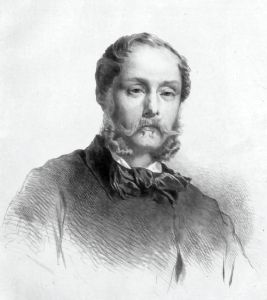
The Formative Years of a Master Painter
Charles Joshua Chaplin, an artist whose work epitomized the elegance and grace of 19th-century French painting, began his artistic journey at a prestigious institution known for shaping some of the most notable artists of his era. Born in Andelys, France, in 1825, Chaplin embarked on his formal education in the arts at the École des Beaux-Arts in Paris in 1840. This period marked the beginning of a flourishing career that would see him become one of the most revered portrait and genre painters of his time.
Early Life and Artistic Inclinations
Charles Chaplin’s early life was steeped in an appreciation for art and culture. Growing up in a family that supported his artistic talents, he developed a keen eye for beauty and a profound understanding of artistic techniques from a young age. His enrollment at the École des Beaux-Arts was a significant milestone, aligning him with an institution renowned for nurturing artistic talent and innovation.
The École des Beaux-Arts: A Nexus of Talent
The École des Beaux-Arts in Paris has a storied history as one of the most influential art schools in the world. Founded in 1648, it has been the crucible for countless artists who have shaped the course of art history. In the mid-19th century, when Chaplin began his studies, the school was a hub of creative energy and intellectual exchange. It provided an environment where young artists could refine their skills, experiment with new techniques, and immerse themselves in the rich traditions of European art.
Studying Under Michel Martin Drolling
During his time at the École des Beaux-Arts, Chaplin had the privilege of studying under Michel Martin Drolling, a distinguished painter known for his historical and genre scenes. Drolling, a pupil of the famous Jacques-Louis David, brought a classical rigor to his teaching, emphasizing precision, composition, and the importance of capturing the human form with anatomical accuracy.
Michel Martin Drolling was more than just a teacher; he was a mentor who influenced many burgeoning artists. Among his students were notable figures such as Paul Baudry, Jules Breton, and Jean-Jacques Henner, who, alongside Chaplin, would go on to make significant contributions to the world of art. The presence of such contemporaries fostered a competitive yet collaborative atmosphere, encouraging Chaplin to push the boundaries of his creativity.
A Flourishing Artistic Community
The 1840s in Paris were a time of vibrant artistic activity. The city was a melting pot of ideas and influences, with artists from various disciplines converging to exchange thoughts and techniques. This period saw the rise of Romanticism and the early inklings of Realism, movements that sought to capture the emotional and everyday aspects of life, respectively. Chaplin’s education was not confined to the classroom; the bustling Parisian art scene provided a dynamic backdrop for his development as an artist.
Chaplin’s contemporaries at the École des Beaux-Arts, such as Paul Baudry, known for his exquisite murals and portraits, and Jules Breton, celebrated for his depictions of rural life, were part of a generation that sought to blend academic precision with a deeper emotional resonance. This blend is evident in Chaplin’s own work, which combines meticulous technique with a sense of grace and elegance.
The Impact of Early Education on Chaplin’s Career
The rigorous training Chaplin received under Drolling’s tutelage laid a solid foundation for his future work. His early pieces reflect a mastery of classical techniques, yet they also hint at the delicate charm that would become his hallmark. Chaplin’s ability to capture the subtleties of human expression and the softness of his brushwork distinguished his portraits and genre scenes from those of his peers.
As Chaplin’s career progressed, he became known for his portraits of women and children, works that exuded a refined beauty and a gentle, almost ethereal quality. His time at the École des Beaux-Arts, coupled with the guidance of Drolling and the stimulating environment of mid-19th century Paris, played a crucial role in shaping his artistic vision.
Conclusion
Charles Joshua Chaplin’s formative years at the École des Beaux-Arts were instrumental in his development as an artist. Under the mentorship of Michel Martin Drolling and alongside contemporaries who would also leave their mark on the art world, Chaplin honed his skills and cultivated a unique artistic voice. His early education set the stage for a career that would bring him great acclaim and establish him as a master of portraiture and genre painting. Chaplin’s legacy is a testament to the enduring impact of his early training and the vibrant artistic community of 19th-century Paris.

